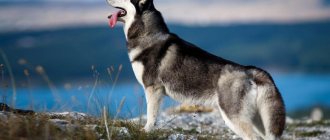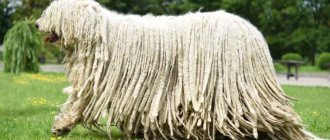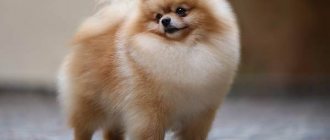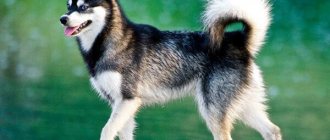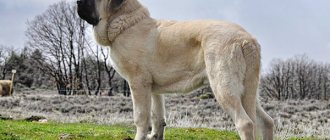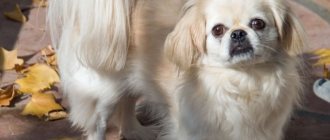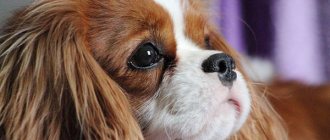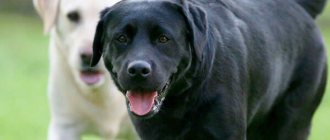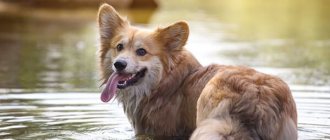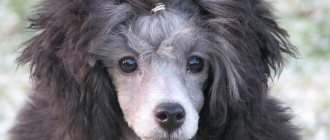- October 18, 2018
- Dogs and hunting with them
- Kira Ifeevskaya
There are a huge number of different dog breeds in the world. Each of them has only its own properties and can perform certain functions. The northern husky, photos of which show all the power and grace of the animal, is today in great demand as a pet. This is one of the oldest breeds that faithfully serves people. To find out what types of likes there are, you need to figure out for what purposes people can use them. Based on many characteristic features, one can judge that they were once closely related to wolves and jackals.
Different types of huskies in different parts of the world were used by people to serve in the areas and spheres inherent in these places. The centuries-old use of these dogs to perform certain jobs has divided them into several groups: herding, sledding and hunting breeds. Let's look at the varieties of huskies that correspond to these groups.
Shepherd huskies
Representatives of this group trace their ancestry back to Nenets Laikas. These are small, light and compact dogs. The height at the withers is about 45 cm for males and 40 cm for females. To protect them from the harsh northern climate, they are given long, warm wool. The skull is wide, the forehead is moderately convex with a clear transition to the muzzle. The muzzle itself is shorter than the skull, the cheekbones are dry, tightly covered with skin. This subgroup is most optimal for shepherd service and is an excellent assistant to shepherds. Despite the fact that the husky is small, it has proven itself excellent in hunting waterfowl, wild birds, squirrels and, surprisingly, bears.
These dogs have a square body, triangular ears, strong paws and brown eyes. This type of husky is endowed with a short fluffy tail, curled into a half ring. The muzzle of such dogs is decorated with whiskers, the chest and neck visually represent a collar with a frill. The front and hind legs have breeches and feathers. The long and dense coat on the lower part of the paws makes them larger, which allows this type of husky to easily move across endless snowy expanses without falling into the snow. A coat of eight centimeters protects dogs from high frosts down to minus fifty degrees, and from forty-degree heat, as well as from annoying gnats and midges. Due to such a thickness of wool, they are not even in danger of being burned when they come into contact with a hot stove.
Shepherd huskies have different colors: black, gray. You can also find representatives of the breed that are brown with splashes of white. This type of huskies has an amazing sense of smell, which allows them to warn shepherds in advance of approaching danger. These dogs are gentle, have a lively and active character, are very sociable, but they show distrust of strangers. Very self-possessed and psychologically stable. They cope well with herding functions and have good hunting skills. Their characteristic qualities include courage, resourcefulness, and balance.
Health
East Siberian huskies are distinguished by good health. The average life expectancy is 10-12 years, but there have been cases of longevity. Many dogs, with proper care and proper exercise, can live 14-15 years, remaining in excellent working shape.
Diseases
Laikas are not susceptible to genetic pathologies. But they are characterized by diseases associated with hunting activities:
- Leptospirosis. While walking or while hunting, a dog can eat a mouse and become infected with this disease. Or be bitten by a marten or weasel, which can also cause infection.
- Esophageal worms. While hunting, the East Siberian husky can catch and swallow a small rodent suffering from this infection. And thus she becomes infected.
- Snake bites. The viper is the enemy of huskies. Often the dog strives to enter into a fight with a dangerous opponent. A snake bite to the neck area is especially dangerous. The owner must have anti-snake serum with him. This will help save your pet from death.
Vaccinations
A healthy dog is the owner's concern. Carrying out routine mandatory vaccinations will protect your pet from dangerous fatal diseases, one of which is rabies. Owners of huskies are advised not to miss vaccination dates, as the dog is especially susceptible to diseases when in contact with wild animals. Before vaccinations, a number of preparatory measures must be taken:
- Expulsion of worms. Almost all puppies are infected with worms. Two weeks before the expected vaccination, dogs are given anthelmintics.
- Flea and tick treatment.
- A visit to a veterinarian who will give an opinion on your health status.
Complex vaccines allow you to simultaneously vaccinate your dog against a number of diseases. The Nobivak vaccine has proven itself well. The veterinarian selects an individual immunization schedule.
The standard schedule is:
- The first vaccination is at the age of 8-10 weeks. The dog is vaccinated against diseases such as canine distemper, adenovirus infection, parvovirus, parainfluenza.
- After 2 weeks, revaccination is performed.
- The third is after a complete change of teeth, usually at 6 months. The same vaccine is administered as at 8-10 weeks, plus anti-rabies serum is added.
- The next vaccination is at the age of 12 months. All previous vaccinations are completed.
Riding huskies
Dogs that perform draft functions belong to the group of sled huskies. Their height at the withers is about sixty centimeters. This is the largest subgroup, extremely necessary in the north, where there are no roads, and they have to cover huge distances only by dog sleds. This special type of husky has undergone a harsh selection by nature and has developed its outstanding qualities thanks to long-term living in very difficult conditions. As a result of centuries of selection, the coat of such dogs has become dense and hard, with a soft, thick undercoat that prevents the dog from freezing even in the most severe frosts.
Sledable huskies have a stretched body and long paws, which allows them to move freely in deep snow. They are very unpretentious and can easily tolerate periodic and monotonous meals. Their ancestors are considered to be the North Kamchatka dogs and the wild wolf. These dogs are perfectly adapted to local conditions and are capable of transporting not only people, but also large loads over long distances in any weather conditions. As a rule, all types of huskies in this group can make decisions independently in the most extreme situations. There is a lot of evidence of how dogs returned for a musher who had fallen from the sled, dug out people and cargo in snow avalanches, and found the right path during a snowstorm.
History of the breed
Today, it is almost impossible to find reliable information about how this dog breed developed. Experts attribute this feature to the fact that in the northern conditions no one paid special attention to these dogs and did not specifically select them. Laikas lived next to people for many centuries, performing very important work, but at the same time they were not treated in any special way. Until recently, representatives of the breed were called “pointy-eared”, “northern” or “yard” dogs, but they became “likes” much later.
The oldest image of dogs was found on a fresco in a temple, whose construction dates back to the time of the existence of Ancient Kievan Rus, which means that the four-legged animals were somehow different from their own kind. Most likely this is due to the fact that in Western Europe hunting was a fun pastime, while in the northern regions and Siberia a person simply could not survive without such a trade.
The first breeding work with huskies was carried out by hunters: Poplavsky, Dmitrieva-Sulima and Shirinsky - Shikhmatov, and this happened in the last years of the 19th century. These people promoted the breed, classified huskies and built several large nurseries. From their trip to the northern lands they brought back the best representatives of pointy-eared dogs, which they purchased from the local population.
In 1925 of the 20th century, the first breed representatives were approved, which were brought to the First All-Union Exhibition, hence the popularity of huskies began. During the Great Patriotic War, northern dogs were used to walk in sleds, search for mines and perform other necessary functions. At the end of hostilities in our country, there were more than 60 nurseries of hunting dogs of various breeds, including huskies.
Breed standards were developed at the end of the 40s; they exist for a number of varieties of these four-legged animals.
What breeds are sled dogs?
The group of sled huskies includes a variety of breeds. In Chukotka alone they use three types. The Eskimo, Greenland and Kamchatka sled dogs have some differences. Kamchatka specimens are slightly larger; they do not have a pronounced characteristic mask. There are visible light circles under the eyes, making them look like Alaskan Malamutes. In this group, representatives of all breeds of huskies are strong and muscular, which allows them to successfully pull the strap not only in deep snow, but also on strong crust or ice.
The group of sled dogs includes:
- American Indian dog;
- West Siberian Laika;
- Norbotten Spitz;
- Shiba Inu.
All these varieties of sled dog breeds are very strong and hardy, with strong and powerful bones and a very developed chest.
Training and education
Laikas are very smart and capable of learning. But it is not recommended to train him immediately after purchasing a baby. First, they take the puppy for a walk, accustom him to the street and a leash. Then they offer active games (ball or stick). From the age of three months it can be prepared for training. According to the characteristics, the dogs are easy to train and have a good memory. They are able to learn 2-3 commands at once.
From the age of 10 months, the puppy is taught hunting commands. The dog must obey its owner unquestioningly. Training is recommended to take place at special sites. On them, the husky will be able to get used to gunshots and headlights.
When the dog has learned to obey the owner in everything, he is trained on an animal (usually one type). I especially like group classes, where the pet can watch more experienced dogs and repeat everything after them.
To motivate your husky, you need to reward it with a kind word or treat.
Basic commands that a dog should know: take, come to me (with prey).
Hunting huskies. Description
Hunting huskies are the most numerous of all hunting dog breeds. This breed is considered universal for hunting and dates back to the times of ancient people, when only the dog was tamed and began to help man hunt other animals. They have a well-developed hunting instinct, excellent sense of smell, excellent hearing and acute vision. They have a quick reaction and can be used for hunting fur-bearing animals - sable, marten, squirrel, mink, ermine. In addition, the hunting husky (its photo is presented in the article) has proven itself excellent in hunting birds and large game - wild boar, elk, bear. Its task is to find the game and bark at it in order to indicate to the hunter its location, as well as to divert attention to itself.
These are nimble, active dogs, they need to work and expend energy. With a lack of physical activity, huskies become sad, which is why they can begin to misbehave: damaging furniture and shoes, making noise, howling.
Let's look at some types of hunting huskies, the most popular and frequently encountered.
Training for hunting
Laikas have a hunting instinct from birth. The owner's task is to help the dog discover its talents.
Elk
When hunting elk, speed and the ability to dodge blows are important. It is better to train a dog in early spring or autumn, when it is cold but there is no snow. Ideally, it is better to take a hunting husky to a mountainous area, where the dog can move easily, unlike a hoofed animal.
It is better to choose a weaker animal, so that it is easier for an inexperienced dog. It is recommended to kill the first victim, and praise the dog and feed it well.
Bear
Bear hunting can begin when the husky turns 2 years old. Ideally, you should first show the dog a dead animal and watch the reaction. If the dog gets scared and starts to run away, you should not train it. If the acquaintance went well, the hunting husky is accustomed to the smell, showing bear tracks and places of bedding.
When hunting for large animals, you should use only powerful and nimble huskies - if the dog fails to avoid a blow, the result can be disastrous.
Boar
Hunting a wild boar is dangerous because it can rip open a dog with its fangs. Therefore, it is better to carry out training in an enclosure, where the owner is able to control the behavior of both the hunting dog and the pig. It is good if the pet stays within 5 meters of the victim. When dealing with a boar, courage and perseverance are important.
The dog must run away, not allowing itself to be wounded, and then again press the animal, notifying the owner by barking.
Squirrel
It is better to start learning to hunt with training on a squirrel. When chasing this animal, the husky will learn to keep track and make a voice. It is recommended to kill the first squirrels the dog finds so that the pet can see the result of its work.
Marten
It is better to train a hunting husky on a marten when the dog is 10 years old. If the owner does not want to wait that long, you can place a young dog next to an already trained dog so that he can learn everything from his experienced brother.
The procedure for training a marten includes getting used to the scent of the prey and keeping a scent.
Ducks
The first time the husky is taken to a proven place, where the hunter has already visited and clearly knows that there are ducks there. It is worth training only those hunting dogs that are hardy enough and love water. When training, it is important to ensure that the dog not only brings game, but also waits for the moment when the owner takes the carcass.
Upland animals
Training a hunting husky to hunt upland game is fundamentally no different, be it working for wood grouse, hazel grouse or black grouse. To train a dog, it is better to choose the summer-autumn season, when new broods are not yet frightened and are difficult to fly.
Russian-European. Description of representatives
The Russian-European Laika is a dog of medium height (52-58 cm), strong build and lean constitution, agile and lively, with well-developed muscles. She has a wedge-shaped head with a wide skull, the muzzle is shorter than the length of the skull, the transition from the forehead to the muzzle is hardly noticeable, the cheekbones are clearly defined. The eyes are cheerful, oval, with a slight slant, and the ears are triangular and erect. The legs are straight and level, the tail is curled and pressed to the back or thigh. The coat is coarse and thick, long and straight, with a dense soft undercoat. There is a lush collar of wool and scruff on the neck, shoulders and withers. On the hind legs the hair is longer and shaped like pants. Colors include black, piebald, white, red and zonular.
The dog has a very friendly character, is very independent and balanced, it is characterized by agility and playfulness, devotion and loyalty to the owner. It should be washed and bathed only when necessary, since dogs are very clean and tidy.
Buy | sell
| I'll give it to good hands Moscow April 18, 2020 Domestic mixed-breed puppies, 2 months old, g/w, different colors, will grow to be of medium size, very affectionate, cheerful and sociable, waiting for a reliable… |
| I'll give it to good handsMoscowApril 5, 2020 Cheerful Butch is looking for a home! Age: 3.5 years. Weight: 34 kg. Height: 65 cm at the withers. Healthy, vaccinated, neutered. Temperament/character: choleric and extrovert. ... |
| I'll give it to good hands Moscow March 29, 2020 Beautiful mixed-breed husky puppies, 2 months old, very smart, domestic, different colors: gray, black, black and white. Very good dogs for a family with… |
| 10 Belgorod8 February 2019 West Siberian Laika puppies, born 12/21/19, two boys and two girls |
| 5000 NovosibirskOctober 11, 2018 Selling West Siberian Laechkas. Purebred. Parents are workers. D. r. 09/04/2022. |
| 5000 Krasnodar25 April 2018 Laika puppies, born on March 13th. 1 boy left -5000?, and 3 girls -3000? . Parents with a passport. Mom is pure white. I'll give in!!! |
| 40000 January 17, 2018 I am selling a male West Siberian Laika, date of birth November 17, 2016, origin (Zyar VPKOS No. 1987/11 - Umka St No. 391-1631/LZS) Male with character, ... |
| I'll give it to good handsMoscowDecember 10, 2017 Our dear Linda looks a little like a cute fox with a neat face and house-like ears. Linda is a West Siberian Laika mix. Very devoted... |
| I'll give it to good hands Moscow November 25, 2017 We present to your attention a West Siberian husky mixed breed named Chuk. Our Chuk looks like both his mother Laika and a real gray wolf. Special charm... |
| 12000 September 18, 2017 West Siberian Laika puppies with pedigree for sale. There are 4 males and 1 female in the litter. Parents at field tests have diplomas in bear, badger, ... |
| Norilsk27 August 2017 Husky puppies for sale. The West Siberian Laika is a Russian breed of universal hunting dog. A dog of average and above average height, strong, dry... |
| 13000 May 20, 2017 West Siberian Laika puppies for sale from working studs with a pedigree. Born on April 18, 2022. There are 3 males in the litter. and 3 females. Father is a worker... |
| I'll give 100 to good handsMoscowApril 5, 2017 I will give into caring and loving hands a very active, intelligent, kind and affectionate girl, a West Siberian husky mix. Age 5 months. Bonya has been processed... |
| 20000 Murmansk February 27, 2017 I will sell puppies with a pedigree (stamp and metric of the puppy). Born January 13, 2022. Working parents (confirmed by diplomas). Call for details. |
| 12000 Krasnoyarsk February 6, 2017 West Siberian Laika puppies for sale. The parents are of high breed, have EXCELLENT exterior grades, diplomas in bear, boar, badger, and squirrel. ... |
| 15000 ShaturaDecember 20, 2016 1. Breed: ZSL 2. Number of puppies (males/females): 2/2 3. Date of birth of puppies: October 23, 2016 4. Color: male No. 1: gray-red with white male No. 2:… |
| 1000 mating Podolsk November 8, 2016 Male ZSL for mating in Podolsk, Moscow region. From working parents. Works properly on squirrels. We can take two or three puppies. |
| matingBryanskOctober 24, 2016 Male Trans-Siberian Laika, with pedigree, age 2 years. |
| 12000 October 13, 2016 Laika puppies for sale. Breed: West Siberian Laika Number of puppies in the litter (males/females): 3/3 Date of birth of puppies: September 6, 2016 Color:… |
| 10000 September 12, 2016 I will sell West Siberian Laika puppies from working parents. Date of birth 08/22/2016 Parents are commercial hunting dogs, they work in the taiga fur... |
| Istra12 July 2016 wonderful puppies with excellent pedigree from real hunters. boys and girls. Inexpensive. Born May 30, 2016 |
| 5000 Novomoskovsk16 May 2016 Zapodnosiberian Laika puppies mom and dad with documents |
| 10000 KrasnoyarskMay 2, 2016 I will sell LZS puppies from working fur dogs. The puppies were born on March 25th. There are 2 males and 2 females in the litter. |
| I'll give it to good hands Kazan April 19, 2016 We will give a West Siberian husky puppy to our home. she is 1.5 months old, very cute. . . . . it's hard for her in the apartment |
| 10000 Krasnoyarsk April 7, 2016 I will sell Laika puppies from working, purebred Laikas. Puppies were born on February 20, 2016. Parents in the taiga work on sable, elk, badger and wood grouse. For sale… |
| 4500 Ryazan April 3, 2016 Selling puppies from working parents. bargaining is appropriate |
| 20000 Lyubertsy2 March 2016 5 puppies for sale, gray red color. Distribution of puppies, February 19. Father of the puppies p.ch. Grip line p.p.p.p. Zuban Vronsky A.Yu. bitch then male p.p. Vagaya… |
| matingKirovFebruary 25, 2016 We offer West Siberian Laika, male, 3 years old. Thoroughbred, with documents. |
| 1000 February 10, 2016 I sell West Siberian Laika puppies, born November 10, 2015. Parents are workers (ungulates, fur). Two bitches left. 8 (960) 545-98-11(Margarita) |
| matingSochiJanuary 27, 2016 |
West Siberian Laika. Description of the appearance of the breed representatives
The West Siberian Laika is similar in height and constitution to the Russian-European Laika. Its height is 54-60 cm. The head has a wedge-shaped structure, the length of the muzzle is almost the same as the width of the skull, and the occipital protuberance is strongly pronounced. The transition from forehead to muzzle is smooth. The ears are elongated triangular, the eyes have an oblique cut. The neck is lean and muscular, the chest is wide and the withers are developed. The belly is tucked in, the tail is crocheted, the paws are straight. Thick hair on the neck, shoulders and withers forms sideburns and a collar. Color black, white, brown, red, zoned. Representatives of this breed are very smart and intelligent, have excellent contact with the owner, but are distinguished by their touchiness.
Feeding
Laikas are very unpretentious in food and can live without food for a long time. How to feed the pet is up to the owner, but this choice must be made immediately.
When feeding dry food, preference should be given to foods high in fat and protein.
If the owner prefers natural food, you need to create a balanced menu, in which the main component will be meat (raw and cooked). You need to diversify the menu with fish, dairy products, cottage cheese, eggs, fruits and vegetables. It is advisable to fill the latter with sunflower oil. But smoked meats, sweets, legumes, pasta and bread should be excluded from your pet’s diet.
Laikas eat much less than other hunting dogs. You need to feed so that the animal is full, but not overeated!
Karelo-Finnish. Description of the breed
Many people do not know the name of the red husky breed. This breed is called Karelian-Finnish because this husky was bred by crossing Karelian and Olonets hunting dogs with Finnish Spitz. This is a very friendly and cheerful dog, bright red and with its muzzle similar to a bear cub. The Karelian-Finnish husky is small in size - only 42-48 cm at the withers, but strong and incredibly agile. Her head is wedge-shaped, the transition from forehead to muzzle is almost imperceptible.
The muzzle is pointed, the ears are oval, small and erect, the eyes are slanted. The withers are well developed, the back is straight and muscular. The paws are straight, the tail is a ring. The coat is straight, hard and very dense with a lush soft undercoat. There are feathers on the hind legs. On the shoulders and neck, the long coat forms a lush, rich collar and stylish sideburns. These cute red huskies (photos of them are presented in the article) have a kind, playful disposition, are very peaceful and friendly, have excellent contact with children, but do not tolerate loneliness well.
Despite her rather modest dimensions, this red-haired beauty has a proud character and is not particularly obedient. Training her will take a long time and painstakingly. But her easy-going nature and cheerful character compensate for these difficulties and make the training process fun for both the dog and its owner. She is very cheerful and charismatic, but at the same time willful. She loves independence and autonomy, is extremely suspicious of strangers and adores her own. She also has an amazing memory.
How to choose a puppy
When choosing a puppy, you need to decide what it is for. If the future owner is an avid hunter, then you need to buy it from hunters. They will not only select the most suitable puppy, but will also give recommendations on training hunting skills. You should definitely familiarize yourself with the pedigree and work achievements of the parents, examine the appearance and study the medical documents of the baby. If you do not plan to show the dog at shows, you can purchase a puppy without a pedigree.
It is also advisable to study the description of the breed: some colors (marble, coffee and others) are considered defects. At 4 weeks, the baby’s ears are triangular, sharp, and deep-set; by 3 months they rise. You also need to choose a puppy with dark eyes. Light eyes most often darken with age, but it happens that they remain that way (light eyes are a defect). The coat is thick and soft, otherwise the dog will freeze in cold weather. Puppies are not lethargic and passive (this is a sign of illness).
It is very important to give a suitable nickname. For males, nicknames such as Adam, Thunder, Whirlwind are recommended, for females - Amanda, Naida, Taiga.
Pros and cons of the breed
It would seem that this breed consists of only advantages, but if you look closely, you can find small disadvantages. Pros and cons of the breed:
| pros | Minuses |
| Good health | Can't stand strangers |
| Magnificent Hunter | Freedom of movement is essential |
| Beautiful appearance | Requires attention |
There are many more advantages. But when buying, you should remember that a sofa dog cannot be made from a husky.
Caring for the Karelian-Finnish Laika
When you decide to adopt a Karelian-Finnish Laika into your family, you must understand what kind of care she needs. Her restlessness requires a mandatory long walk. Long hair requires grooming to prevent tangling. This husky sheds twice a year, but apart from combing out the old fur, it does not require any other care. It does not have a sharp specific odor, so it is washed only once or twice a year. She needs her own place, and food should not be near her rookery.
Pros and cons of the breed
Advantages of the Laika breed:
- high intelligence;
- love for the owner;
- lack of aggression;
- good health;
- unpretentiousness in maintenance and food;
- ability to quickly make decisions;
- endurance and good performance;
- adaptability to conditions of detention.
Flaws:
- not suitable for living in an apartment;
- often needs professional training;
- too stubborn.
Siberian Laika
The Siberian Laika (pictured below) is a northern beauty. This is a very intelligent hunting dog with well-developed intuition and an exceptional sense of smell. Representatives of the breed are very dexterous and friendly, loyal and faithful. This is one of the breeds that has retained its essence almost in its original form. These dogs are closest to nature and the ancestors from which they originated.
The Siberian is the largest breed of Laika. She was bred in harsh natural conditions. Siberian huskies are divided into two types - East Siberian and West Siberian. The second type has already been mentioned above; now the East Siberian breed should be highlighted.
Compared to its West Siberian relative, the East Siberian Laika has a more elongated format and larger sizes. Its height at the withers averages 55-65 cm, sometimes reaching seventy centimeters. In addition, she has a stronger bone structure and a stronger body. The head is wedge-shaped with a wide skull and a rounded nape. The length of the muzzle and skull are almost the same. The transition to the muzzle is smooth and imperceptible. The ears are triangular, erect, very mobile. The eyes are oval with a moderately oblique slant. Muscular neck and well-developed withers, powerful straight back. The paws of such a dog are straight and muscular. The tail of representatives of the breed is curved in a ring. Very fast and light dogs, easily moving from gait to trot and gallop.
Despite their large size and strong body, these huskies are very active and mobile. Their weight is about 20-25 kg. These powerful animals have a very quiet and calm character. They are not at all aggressive, they are well versed in the terrain, very dexterous, maneuverable and incredibly brave. Thanks to their distinctive qualities, they have proven themselves excellent in hunting. They love to play with a ball or a stick and do not show aggression towards humans.
The dog can serve as a sled dog, pulling children in sleds. She is attentive and fearless - if her owner is in danger, she will do everything to protect him. They have an excellent natural instinct, which helps them to always be on guard and cope well with their security duties.
Possible diseases and methods of treating them
The West Siberian Laika has no hereditary diseases. However, even these strong dogs end up at the veterinarian's office with dislocated and broken legs. Typically, limbs are damaged only by those individuals that regularly hunt in the forests with their owners.
There are practically no preventive measures aimed at minimizing the risk of injury to limbs during hunting. It is important to take your dog to the hospital in a timely manner if he tightens his limb and whines loudly. These symptoms clearly indicate injury.
To keep your dog healthy, be sure to check his teeth, eyes, and ears regularly. They will have to be systematically looked after. And, of course, improve your pet’s health with vitamin complexes for animals.
Siberian Laika. Where is the best place to keep and how to care for such a dog?
The East Siberian Laika feels best in a spacious enclosure, but adapts well to life in an apartment. It’s just that the owners should always remember about the incredible activity of the pet and give it the opportunity to frolic for a long time in the open air - run, bark. Thick and long hair will be subject to periodic shedding. Therefore, you will have to comb the dog thoroughly and be prepared for the fact that during this period, pieces of fur will be scattered throughout the house.
Anyone who prefers silence will not be able to be close to a loud and restless husky. It is better if her owner is a hunting enthusiast, then she will periodically show her skills. If you don't like long walks and jogging, don't adopt this breed - it will be a burden for you and a pain for the animal. The East Siberian Laika is very prudent in its diet - it often eats in reserve, which is a very useful property for a hunting dog, which can be on the hunt for several days and does not require feeding.
Maintenance, care
The thick fur of huskies allows the animals to feel great in low temperatures. It will not be difficult for them to settle down to sleep right in a snowdrift. But in hot climates, representatives of this breed are extremely uncomfortable. It is recommended that such a dog be kept outdoors rather than indoors.
Laikas are very active animals, and therefore they need to be walked for a long time every day and at the same time given physical activity.
When walking, it is best to choose an open space located as far as possible from the highway. If there are no such places, then the pet needs to be walked without letting it off the leash.
Representatives of this breed are distinguished by cleanliness, but frequent washing is contraindicated for them due to the thickness of the undercoat, which dries very poorly. To take care of the coat, the owner needs to comb his pet several times a week and use dry shampoos.
Feeding
After a husky puppy appears in the house, the owner’s first need is to provide the animal with daily nutrition. Here you can use both specialized (store-bought feed) and natural products. It is strictly forbidden to mix both of these options.
The growth and development of a dog depends on the diversity of its diet, especially in the early stages of life, when skeletal bones, muscles, etc. are being formed.
Worth knowing! Until six months of age, the puppy should eat 5 to 6 times; after the 6th month, reduce the number of meals to 3 to 4 times a day.
Adult animals should receive food twice a day, in the morning and evening. It is important to remember that the dog should always have a bowl of clean drinking water available to him.
The natural diet is represented by boiled or steamed food. The permitted products include the following:
- beef;
- pork;
- rabbit meat;
- bird;
- fish;
- milk products;
- occasionally raw eggs;
- vegetable crops.
There are some types of food that you should absolutely not give to huskies. This includes not only smoked, fried, salted and spicy foods, but also the following:
- pea grain;
- potato;
- wheat bread;
- sweets in any form;
- pasta.
A dog’s health and life expectancy depend on a high-quality diet. If you follow all feeding standards and properly care for your husky, it will live for about 10–15 years.
Upbringing
Before you bring the puppy home, you need to choose a place where he will sleep and eat, they must be strictly defined. A potential owner should remember that the puppy will go to the toilet after feeding and after waking up. To avoid further problems, the puppy must be taken outside on time, where he will relieve his natural needs. The main thing in this matter is perseverance and perseverance, only then the pet will begin to understand what it must do. By the age of two months, a husky puppy should have a clear idea of where its place is, where feeding occurs, obey the command “come to me” and have the correct reaction to the sound of a whistle, which will replace the voice command during the hunt.
Continuation of the reinforcement of this command and the call signs of the whistle must be reinforced after the puppy turns three months old during full walks. At this point, it is necessary to begin training the main commands. By 4 months of age, properly trained young dogs are mostly effortless and can do all of the above.
To stimulate obedience, it is important not to forget to praise the dog and give it its favorite treat, which the husky will appreciate.
When raising a puppy, the owner must show persistence and firmness, but there should not be excessive cruelty. You need to know all the inclinations and characteristics of your pet in order to use them to develop the necessary skills in the animal. If there are harmful tendencies, then they must be nipped in the bud, otherwise they will later become habits that will be very difficult to get rid of. The laying of the foundations of education for this breed continues until the age of one.
Samoyed husky. Description of representatives of this species and their character
The Samoyed is also a fairly large dog, covered with thick white hair. It is able to withstand the incredible frosts inherent in the Arctic winter, with strong cold winds. The average height at the withers is fifty to sixty centimeters. Dogs may deviate slightly from the white color and take on a cream color.
The peculiarity of the Samoyed is its smiling mouth. This dog can also be used as a sled dog. Samoyeds are very friendly and affectionate animals. These dogs have a sociable disposition and are committed to family relationships. They get along well with children of different ages. You can keep a dog of this breed in an apartment. But you should provide her with sufficient stress so that she can use up excess energy. They do not tolerate loneliness well, do not like separation, and miss their owners very much when they have to part.
Character
If you have read or heard somewhere that the West Siberian Laika is a very kind and tame pet, you should know that you have been misled. This thesis is only partly true. There is something wild in the character of such an animal; it is not for nothing that its appearance resembles a wolf.
No, it is definitely possible to tame this dog, but do not expect it to serve you, like, for example, a Labrador or a German Shepherd. This animal is distinguished by its willfulness, some obstinacy and self-confidence. It is recommended to build a partnership relationship with him. What does this mean?
As an assistant and unquestioning servant, such a dog is ineffective. But as a comrade helping to complete a task that is interesting to him, it’s the opposite. Partnerships provide for mutual benefit. The owner gives his pet shelter, takes care of him, trains him, and he, in turn, protects his home, goes on a joint hunt and gives love and tenderness.
Despite their pretty appearance, none of the famous huskies can be called absolutely good-natured. She can snap if any living creature, even a person, begins to behave too intrusively. Being in a bad mood (and this happens periodically with these beautiful dogs), he moves away and spends time alone. Needs personal space.
Not prone to strong excitability. Almost always behaves appropriately. Loves order and certainty, cannot stand chaos. In principle, the Laika is a good and positive dog that easily becomes attached to its owners. She loves to sleep at their feet, spend time together, but most of all she likes going to the forests together.
In densely growing areas it can demonstrate all the hunter’s talents given to it by nature. For example, there are cases when a representative of this breed, at the time of a foray, disappeared into the forest for some time, after which he brought a killed bird or fish to his family members.
Another interesting feature of West Siberian huskies is their flexible intelligence. The ability to make decisions independently and learn quickly are the things that make a dog valuable, and the representative of the breed in question has them.
Well, excellent working potential is passed on to him genetically. Modern West Siberian Laikas are in no way inferior to their ancient and more massive ancestors. They are clever, fearless, inquisitive and very loyal.
It is also worth highlighting a few more specific aspects of the character of such dogs. They truly hate most species of animals. This is due to well-developed hunting instincts. However, thinking that this applies to people is a mistake. Although, they often react warily to suspicious strangers.
The interesting thing is that these wonderful dogs are monogamous. In the world of living nature, this concept extends to those who remain faithful to one living creature. The West Siberian husky will never change its owner; once it becomes attached to a person once, it will remain faithful to him all its life.
How to care for a Samoyed? Peculiarities
Although this breed is very woolly, it is not that difficult to care for. First of all, you need to comb the Samoyed correctly, separating the fur with one hand against the growth of the hair, and with the other, combing the fur in the direction of growth. Do not allow the fur to become tangled, as Samoyeds cannot be cut. When brushing is finished, run the comb against the grain of the hair to lift the undercoat. The dog sheds once or twice a year, and dry shampoo should be used for bathing. Daily walks with intense physical activity are required. Otherwise, such a dog will get bored and may even start acting out (gnawing something or howling).
Vaccinations and susceptibility to disease
Like all dogs, Laika puppies receive their first vaccinations in the first year of life, but vaccinations are not carried out during the change of teeth.
| Age | From what disease | Note |
| 8-12 weeks | Distemper, infectious hepatitis, leptospirosis, parvovirus enteritis | Primary vaccination |
| 11-15 weeks | Similar list | Revaccination (repeated vaccinations) |
| 9-12 months | Parvovirus enteritis, rabies | Last vaccination, then repeated a year later |
Laika bears puppies from 55 to 65 days, it depends on the number of puppies in the litter. If labor has not started before 70 days, then urgently take the dog to the veterinarian. Laika is a hunting breed that can become infected when bitten by a pursued weasel or marten, while in a forest pond, or attacked by a snake. Therefore, if there is a sharp increase in temperature and low mobility of the dog, you should urgently contact a veterinarian.
Lifespan
This breed is distinguished by its exceptional love of constant movement. If you keep your pet busy with running, active games and weekly hunting trips, the husky will live a full life, delighting the owner with its activity in pursuing any animal. The age limit for this breed is 12-14 years.
